First there was 10mm Auto. The FBI chose a watered-down loading — a 180 grain bullet at 975 fps instead of more like 1,300 fps — and a large-frame Smith & Wesson pistol through which to shoot it. By the time the contract went through, Tom Campbell, a Smith employee, had realized that the powder capacity of the 10mm’s 25.2 mm-long case simply wasn’t necessary to achieve this same velocity. And that’s how the .40 S&W cartridge with its shorter 21.6 mm long case was born.
For all intents and purposes .40 S&W is really “10mm Short & Weak.” With that brief history complete, let’s skip to the part where I describe why I’ve chosen to shoot it regularly through stock 10mm GLOCKs.
First, yes, the requisite disclaimer: Don’t do this. It is not okay to shoot a caliber in a firearm that wasn’t designed for that caliber. I’m going to tell you why I do it and why I actually believe it’s safer to shoot .40 S&W ammo in a 10mm GLOCK…safer than either 10mm in a 10mm or .40 in a .40.
But that doesn’t mean I’m suggesting that you do it. So don’t.
Second, this all pertains to a GLOCK pistol. Shooting .40 S&W in many or most other 10mm pistols sans conversion barrel can be problematic or downright unsafe.
Some Background
A competitive shooter I knew in California shot a GLOCK 20 in Production Class. However, he shot .40 S&W from it. No need to shoot the stronger and significantly more expensive 10mm ammo just to make Major power factor, yet he’s an extremely tall guy with gigantic hands and the G20 frame fit him better.
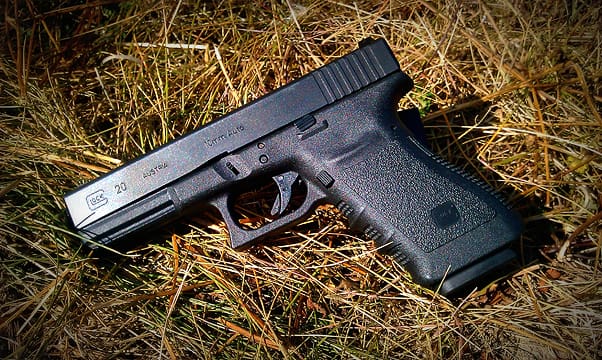
Additionally, the extra mass of the gun made it shoot .40 that much softer and flatter. He shot about 5,000 rounds per year, and was in his fourth year with the same G20 when I met him.
Before the G20, he was shooting a GLOCK 22 until he encountered another bloke who was running .40 S&W through his G20 and claimed to have put many thousands of rounds through it without a hitch.
Confirming complete and total reliability through his G20, I was also surprised to see that once the barrel was cleaned, it was entirely indistinguishable from any other GLOCK barrel. Finish wear on the outside attested to the round count, but the inside was pristine.
Digging into this a little further, I found that this is actually a fairly common practice among the GLOCK set…and I started doing it myself. I got my G20SF I used for bear defense while Huckleberry picking and, coincidentally, for shooting full-power 10mm through it. But when I’m practicing, plinking, and target shooting — or testing out new GLOCK sights — I’m usually shooting the less expensive .40 S&W.
No, I don’t have a conversion barrel and I don’t feel any need to buy one. I also had a Gen4 G29 — the sub-compact 10mm — for about a year and shot a couple hundred .40’s through that bad boy without a hitch.
Why It Works
Many people believe the extractor in a pistol snaps over the rim of the cartridge, but that’s not actually how it happens. As the bottom of the breech face strips the round out of the magazine and the feed ramp lifts the round upwards, the base of the cartridge moves up the breech face, sliding underneath the extractor.

Feeding a .40 S&W round from a 10mm magazine in a 10mm GLOCK pistol follows this process just as it should. Since the .40 S&W brass is 3.6mm shorter, its forward progress isn’t stopped by the end of the 10mm chamber (it doesn’t headspace on the case mouth). Instead, the extractor hangs onto it and keeps it up against the breech face.
Obviously the .40 caliber bullet has a few more millimeters of free bore travel than a 10mm round would before it contacts rifling, but this is far from unique in the firearms world.
Every revolver necessitates bullet travel before rifling is encountered, especially in cases where you’re shooting a shorter, less-powerful version of the cartridge the revolver is designed for. Think .38 Special in a .357 Magnum or the various .32 cartridges from a .327 Federal Magnum. Or heck, a .45 LC out of a 3″-chambered Taurus Judge. Or a .22 Short from a .22 LR.
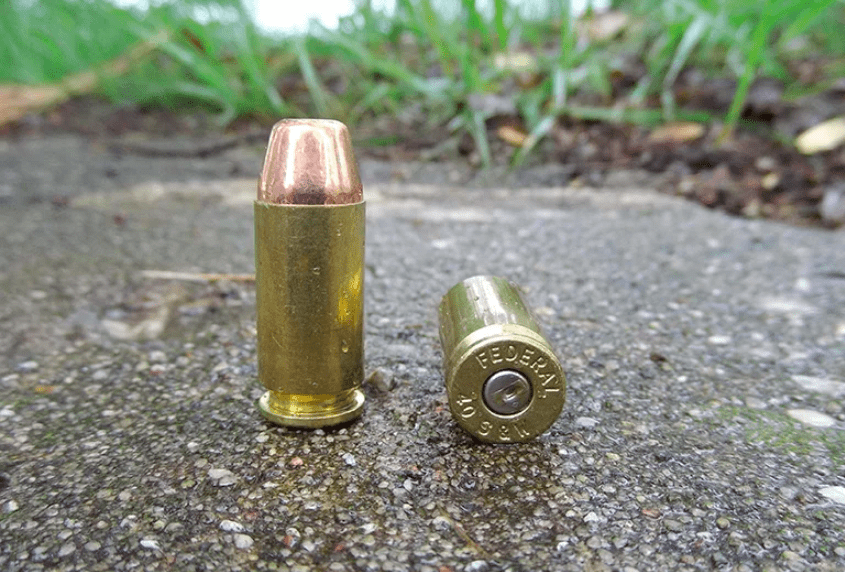
The .40 S&W round has identical exterior dimensions to 10mm, uses the exact same bullets, and has the same rim dimensions, etc. It uses a small pistol primer instead of a large one, is rated for 35,000 PSI instead of the 37,500 PSI of the 10mm, and is obviously a bit shorter in case length and overall loaded cartridge length.
Other than “headspacing off the extractor” instead of the case mouth, everything else is functionally the same as 10mm as far as a GLOCK pistol is concerned.
As a 10mm GLOCK is tuned from the factory to reliably run FBI-spec 10mm, it will run .40 S&W as, again, .40 was designed to be ballistically identical to FBI 10mm. With the exception of brands like Underwood, Buffalo Bore, DoubleTap, and a couple of the big names, much of the “10mm” ammo on the market is loaded awfully close to a given brand’s .40 cal.
For instance, Federal American Eagle and Federal Hydra-Shok have stated velocities of 1,000 fps for 180 grn .40 and 1,030 fps for 180 grn 10mm. In fact, even when I install my 21-pound (a few pounds stiffer than factory) Lone Wolf recoil spring, it still cycles .40 with complete reliability.
Safety
As mentioned, I believe shooting .40 S&W in a 10mm GLOCK is not only safe, but is actually safer than shooting 10mm in a 10mm GLOCK or .40 in a .40 GLOCK.
Here’s why I don’t hesitate to do that . . .
1) Headspace “Kabooms” can occur due to excessive headspace — the distance between the breech face and the end of the chamber (in this case the lip on which the case mouth stops) — caused by the cartridge protruding too far out the back (ejection port side) of the chamber.
With fairly generous chamber diameters and less-than-complete case support — the “GLOCK Smile” appears on .40 S&W and 10mm cases when shot through the correct GLOCK models due to limited case support above the feed ramp — it doesn’t take very much excess headspace to cause a case rupture.
Since these rimless cartridges are designed to headspace off the mouth of the case when it hits the front of the chamber, a piece of brass that’s slightly too long, a bullet that isn’t seated deeply enough, heavy chamber fouling, and/or a slide that doesn’t quite go fully into battery can and does cause this dangerous scenario. Both 10mm and .40 S&W GLOCKs are relatively notorious for case blowouts and this is a big reason why.
Conversely, when the shorter .40 S&W cartridge is chambered in the 10mm chamber, there’s effectively no physical way for it to be anything less than completely chambered. Even out of spec, too-long brass with a shallow-seated bullet is going to have room in the chamber and the slide is going to be completely in battery, as far forward as it’s capable of going. The least headspace possible. Every time.
In fact, this can be seen immediately if you happen to have both a .40 and a 10mm GLOCK handy. Forty caliber brass shot out of the .40 will show the GLOCK Smile (as does 10mm out of a 10mm). Forty caliber brass shot out of the 10mm won’t.
There is no longer any GLOCK case bulge…or at least it’s greatly reduced. The case is more fully chambered and better supported. If you reload, you’ll be happy to know that fired .40 cases look and measure better when shot through a 10mm barrel (case length changes by no more or less than normal, and rims are normal).
2) Overbuilt A 10mm GLOCK pistol has a heavier and thicker slide, a thicker chamber and barrel walls, a stronger recoil spring, and a larger locking block than a .40 GLOCK. In the event of a .40 S&W round that’s over pressure due to excessive powder, a bullet that’s seated too deeply, etc., the pistol is more likely to shrug it off or at least more likely to suffer less damage.
3) Firing Pin This is what makes this uniquely safe in a GLOCK, but a bit sketchy in many other firearms. The big, rectangular slab of a GLOCK firing pin (striker) comes to a hard stop without projecting very far from the breech face. Should the extractor miss the case rim for some reason or slip off of it — neither of which it ever freakin’ does, by the way — the .40 S&W round would plunk down into the chamber, held forwards off of the breech face by the extractor far enough that the firing pin is physically incapable of contacting the primer.
This isn’t the case in some 1911s and other guns. While this still actually isn’t likely to cause a serious safety problem, it isn’t ideal for the case to slam backwards into the breech face and it can lead to pierced primers and worn out or broken extractors, and maybe failures to eject.
The unlikely safety issue would be separation of the case rim/base from the rest of the casing. Again, it won’t happen in a GLOCK because the extractor is either holding the cartridge against the breech face and all is well, or it isn’t and the firing pin can’t reach the primer in the first place.
Primer strikes on .40 S&W cases shot through 10mm GLOCKs look indistinguishable from those shot through .40 S&W GLOCKs. This isn’t usually the case in other pistols with normally-shaped firing pins, which tend to exhibit excessively-deep primer strikes and sometimes pierced primers.
4) Extractor The GLOCK extractor is pretty wide and beefy. A concern for extractor lifespan is probably the #1 “don’t do this because…” thing I hear on this .40/10mm topic after safety concerns are dismissed.
I think the theoretical stress on the extractor from having to stop the round from plunking into the chamber is exaggerated. That forward pull is just nothing compared to how hard it sometimes has to tug on cases to pull them out of the chamber. I don’t deny that the extractor is doing work on the chambering stroke when it usually doesn’t, but I see it as much lighter work than its normal duty and, as they say, the proof is in the pudding.
The proof is in the countless G20s with multiple thousands of rounds of .40 through them with no extractor breakages or issues of any sort. In theory, practice is the same as theory, but in practice it rarely is. It’s also like an $18 part, and it’s not like they don’t sometimes break in by-the-book usage. I don’t think this increases the chances.
Additionally, it’s sometimes the case that the correct cartridge in the correct gun doesn’t headspace on the case mouth anyway. With brass that’s only a little bit on the short side — often even within SAAMI-approved tolerances — it doesn’t contact the end of the chamber. Short is okay, long is bad (see #1 above).
As for any gap between the breech face and the cartridge base, some gap there is really a non-issue on a pistol cartridge and all revolvers have some gap there (between case base and recoil shield) so the cylinder can rotate. The GLOCK extractor pins the round against the breech face under spring tension. The extractor isn’t just hovering there over the rim, it’s actually clamped down on it. There is no gap, and the round is held solidly in place:
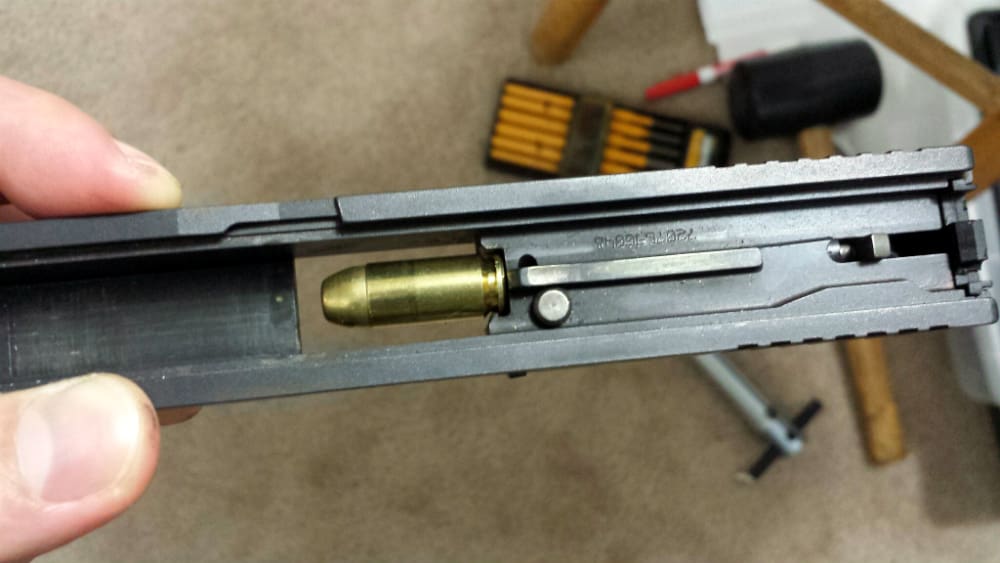
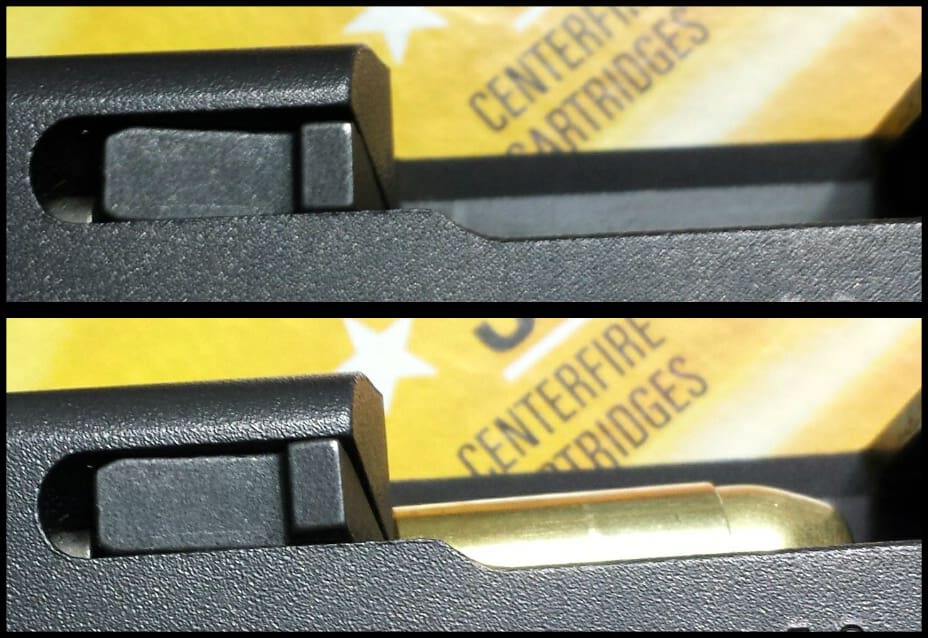
5) Chamber/throat erosion Folks are convinced that the shorter, .40 cal brass means the gasses and bullet will impact the chamber lip and wear it out. Again, I understand this intuitively, but it doesn’t pan out in practice.
The gasses from the pistol cartridge just aren’t hot enough and high-pressure enough to begin to wear away the steel for many, many tens of thousands of rounds. Again, some of the time the 10mm brass isn’t going to seal against the chamber lip anyway.
As the full diameter of either the 10mm or .40 caliber projectile is behind the chamber lip, they both have the ability to touch it. The copper and lead isn’t hard enough to erode that cold hammer forged steel except for, again, after many tens of thousands of rounds exactly as it takes that sort of time for the rifling to get worn down in a standard pistol barrel.
I’ve now seen multiple factory GLOCK barrels with multiple tens of thousands of rounds of .40 S&W through them and, when clean, no GLOCK armorer or gunsmith on the planet could tell by looking at the chamber lip or the bore that .40 was fired through it instead of 10mm.
On The Range
It’s completely reliable. I have never suffered a stoppage of any sort, with all possible combinations of factory barrel, factory recoil spring, Lone Wolf 6.6″ 10mm barrel, and Lone Wolf 21-pound recoil spring. Nor was there a hitch in the couple hundred rounds fired through the unmodified Gen4 G29 that I had.
The guy that piqued my interest in this had never suffered a single .40-in-a-10mm-related stoppage — he encountered a few truly dud primers — and during the competition season in which we were in contact, he was working on rounds ~15,000 to 20,000.
It’s not quite as accurate as 10mm in a 10mm barrel or .40 in a .40 barrel. That little bit of free bore has a very minor, detrimental effect on accuracy. Obviously it isn’t enough to negatively affect USPSA scores. The gun will still shoot groups that anyone would call typical for a GLOCK. However, I did take the time to do various testing around this and group sizes are just slightly larger than when shooting either caliber through its correct barrel.
The Legitimate Safety Concern
As the .40 S&W brass is shorter, shooting it will cause a bit more carbon fouling than usual in the front of the chamber. It is advisable to clean the chamber before switching back to 10mm.
As we’ve already discussed, excessive headspace can lead to a kaboom — especially with a GLOCK-brand GLOCK barrel — and one cause of excessive headspace can be fouling that prevents a round from fully chambering.
It could take a thousand rounds of .40 S&W through a 10mm GLOCK before fouling is such that it’s even a concern for switching back to 10mm, but as there are a lot of variables that can affect the rate and type of fouling there’s no way I’d throw out a suggested round count.
Default should be cleaning, inspecting should be mandatory.
Conclusion
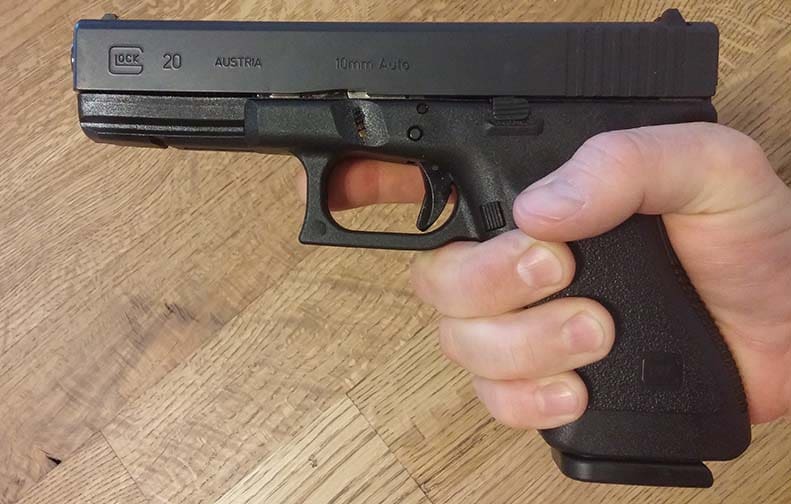
I expect that half of the comments will be folks talking about how stupid this is, how stupid I am for doing it, and suggesting all sorts of theories as to why that is. Again, this is just one man’s experience and opinion.
Don’t do it if you don’t want to (don’t do it if you do want to). As much as I appreciate hearing theories from folks who haven’t done it, haven’t fully thought it through, dismiss it outright because it’s “wrong,” or otherwise intuit or feel various reasons as to why it’ll break your gun and explode in your face, etc., they’re just theories. In practice, this works on all levels.
Again, I’m not suggesting anybody actually do this. You should probably also never shoot .223 in your 5.56 chamber, 7.62×51 in your .308 chamber, 2¾” shells in your 3″ chamber, .22 Short in your .22 LR chamber, etc., etc., etc., ad nauseam. (Yes, I realize these all headspace off the shoulder or rim.)
Random, Unverified ‘Historical’ Note
The verifiable part of this history is that the Soviet military specifically designed and required that its ammunition was incompatible with NATO firearms, meaning no captured ammo could be used against them. The sketchy part of the history is that this doesn’t mean Soviet firearms weren’t made to also run on NATO (or NATO-country) ammunition.
Many folks claim that at least the Makarov, which was chambered in 9x18mm Makarov, was designed to reliably and safely cycle .380 ACP (9x17mm) and can also safely fire 9×19 (9mm Luger).
The larger diameter — 0.365″ vs. 0.355″ — a Makarov bullet can’t be chambered in a .380 or in a 9mm, but the .380 round chambers just fine in a Makarov pistol. While .380 will actually feed from the Mak magazine, fire, and eject reliably, 9×19 has to be dropped into the chamber one at a time. It also exhibits excessive headspace, as you’d expect, but likely thanks to how much gas and pressure blows by the too-small projectile (it doesn’t seal in the bore), it doesn’t blow out cases and doesn’t seem to beat up the pistol.
While there are myriad YouTube videos and forum posts confirming the reliability from .380 and successful function of 9mm (even on aluminum-framed, cheap-o, reproduction Makarovs), it’s probably best left for SHTF use only as either of these instances are more “extreme” than running .40 cal in a 10mm due to significantly larger differences between the rounds vs. the intended cartridge.



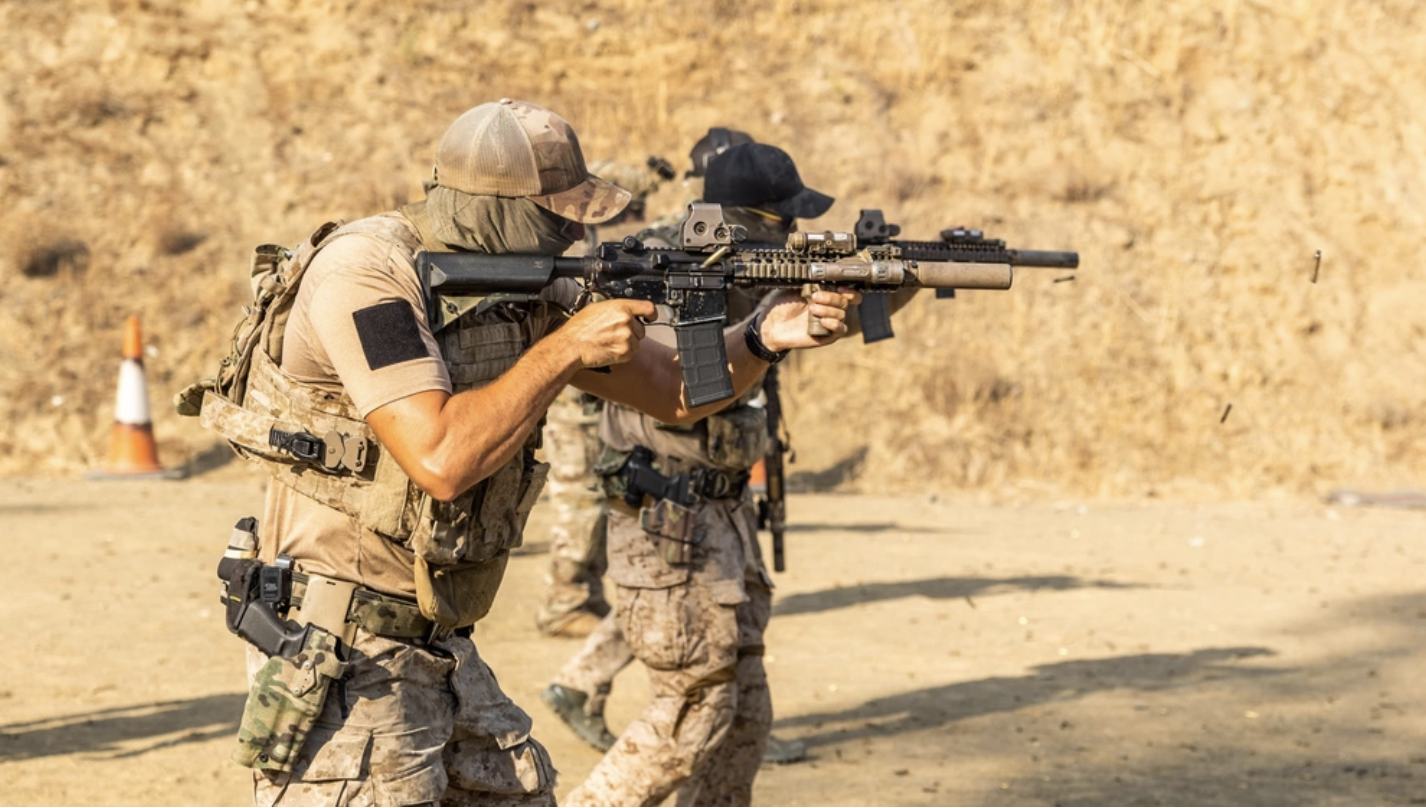





Interesting perspective! I never considered using .40 S&W in my 10mm, but your insights on versatility and ammo availability are definitely worth thinking about. Thanks for sharing your experiences!